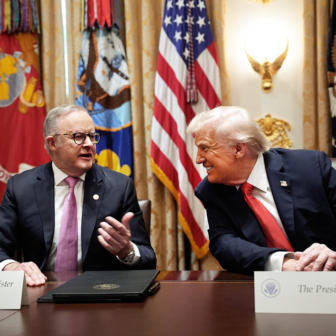Game of Thrones is one of the big global TV hits of the decade. Based on George R.R. Martin’s popular novel cycle, this fantasy drama from US cable network HBO tells a protracted tale of rivalries among noble families in a climate-challenged, mythical, medieval world. Once described by one of its executive producers as “The Sopranos meets Middle Earth,” the series is renowned for the enthusiasm of its fans, manifest in spin-off fiction, social media and, not least, audience numbers. It has been enormously popular on first broadcast, and the DVD box sets and digital downloads have been HBO’s highest selling to date.
Unsurprisingly, Game of Thrones was also a massive hit on BitTorrent. In fact, the website TorrentFreak named Game of Thrones the “most pirated show” in 2012 and again in 2013. One 2012 episode appeared to have been downloaded 4.3 million times, a figure greater than the program’s estimated US television audience.
In August 2013, an offhand comment by the CEO of HBO’s parent company, Time Warner, sparked a media debate about the value of this illegal audience activity. Chief executive Jeffrey L. Bewkes was on a conference call with financial journalists discussing future cable TV earnings for Time Warner, and at one point mentioned the popularity of Game of Thrones on BitTorrent, suggesting that the tag of “most pirated” show in 2012 could be “better than an Emmy.”
A few months later, Game of Thrones writer and episode director David Petrarca also appeared to celebrate its “most pirated” tag during a panel at the 2013 Perth Writers’ Festival. “That’s how they survive,” he said, arguing that high-profile premium-cable shows like Game of Thrones thrived on this kind of “cultural buzz.” “Our experience is, it [unauthorized viewing] all leads to more penetration, more paying subs and more health for HBO.”
These and other observations by high-profile figures sparked debate across the media. Partly, this was because they appeared to deviate from the TV industries’ strong line against piracy. But they are also interesting for a different reason. At its heart, the Game of Thrones controversy was about an alternative metric for measuring popularity, namely BitTorrent downloads. Bewkes’s comments confirmed what many people already suspected: that US TV executives have been monitoring illegal downloads and using this to gauge the popularity of their shows.
BitTorrent downloads appear to have become a kind of informal metric for the industry, sitting alongside the established indexes of audience demand like TV ratings, Hulu streams and iTunes downloads. Like other media metrics, BitTorrent data can be offered to the financial press as proof of a show’s success, used to inform strategies for future production and distribution decisions, and deployed internally to convince executives of the viability of particular series.
Compared to official media metrics, BitTorrent has a further advantage: it is notable for its transparency. A typical BitTorrent client provides a remarkable amount of public information relating to any given download – not only about a particular user, but also about all those people who are currently sharing that file. It includes people’s IP addresses (which can be resolved into host server names), their countries of location, the BitTorrent client software being used, the speed of each download, the progress of each download and exactly what each person is uploading and downloading at any given time. The BitTorrent system also makes it easy to copy the IP addresses of all users, and to log traffic.
Anyone who wants to know more about the popularity of certain genres of movies, television shows, music or games, or is considering licensing or producing a particular program, can use BitTorrent as a data source. Data of this kind is particularly valuable in today’s volatile, fragmenting media industries, where conventional measures such as TV ratings have lost their grip on fast-moving audience behaviour. It is also important because formal platforms like iTunes provide very little public data.
When the internet first emerged as a popular public network of networks, it was entirely outside the formal media and communication industries. There were few tools available to gauge its size or what its users were doing. But as it rapidly developed in the mid 1990s, researchers began to measure various aspects of its architecture and uses.
A new industry of web analytics appeared, based largely on automated analysis of the data already produced by internet servers. “Hits,” “visits,” “page views” and other new terms entered the language. Many of them were not well defined or understood, and, as web technology developed, many were only briefly relevant. They were devoted to the immediate problem of measuring traffic. Attention to what users actually did came later, using more elaborate software embedded in web pages.
The astonishing rise of Google, a company described by its former CEO Eric Schmidt as “founded around the science of measurement,” is testament to this. In the political economy of data industries, a small number of metrical commodities are now extraordinarily important. Even more than television ratings, these metrics are entirely opaque. The algorithms that generate them are secret, ranking possibly among the most valuable of all trade secrets. Discovery and exposure would render them valueless.
It is hardly surprising, then, that metrics of this sort have generated a thriving sphere of enterprise. The search engine optimisation industry constantly develops, tests and sells new ways for improving rankings.
Social theorists Lisa Adkins and Celia Lury have written eloquently about the rise of digital metrics and their increasing centrality to everyday life: Google is perhaps the paramount example. They argue that the internet economy is characterised by “a proliferation of information, data, calculative and other research instruments, measurements and valuations,” which in turn creates its own social realities. Our current big data culture, they say, is leading to “an ongoing expansion of the social by way of techniques of mediation, measurement and valuation.”
This expansion of the social is also an expansion of the communications and media systems that connect people, institutions and industries. Many of these networks and interactions are informal, occurring on social media platforms, through messaging and searching practices that lie well outside the comparatively limited domains of the established media industries, but are increasingly integrated into mainstream internet business.
In the wave of publicity and controversy surrounding Game of Thrones and its famous “most pirated” status, the fact that the series had won out in the rankings was not the primary source of interest. Rather, it was the reaction to it: from the show, the network and others. The idea that TorrentFreak’s recognition was “better than an Emmy” may have been facetious, but it was also subversive because representations of piracy from large media companies are almost always expressed in terms of losses, rather than gains.
Why did Time Warner embrace the TorrentFreak metric? To answer this we need to delve deeper into the business side of the story. Game of Thrones’s circulation followed a distribution pathway well established by HBO, which often sold overseas rights to premium drama cable or satellite channels, and then relied on subsequent physical or digital sales. So when the much-hyped series was screened outside the United States, it was scheduled on many channels with comparatively small audiences. Delays of a week or so after the US broadcast also frustrated impatient viewers. Demand effectively overloaded HBO’s distribution system.
TorrentFreak reported that there were some notable geographic centres of piracy for the second season. London was the chief pirate city, while Australia was the number one pirate nation. In Australia, a market with a historically low level of pay TV uptake, the series was being aired on the premium channel Showtime, a week after US broadcasts. For the third season, in clear response to the piracy figures, changes were made; the delay was reduced to two hours, and episodes were also available on iTunes (an Australian exclusive). The fourth season was exclusive to cable.
Such manoeuvrings reveal something of the complexity of the tactical adjustments of rights holders in a changing environment. A choice must be made between exclusivity and piracy, on the one hand, and broader distribution, on the other; like one of those annoying pay TV bundles, you cannot choose exclusivity without piracy. HBO chose exclusivity plus piracy – a rational choice given the kind of content it produces. Long-form drama of the HBO kind now has just as strong a claim on “quality” as movies do, but the dynamics of demand and distribution are clearly different from most other cinema and TV content.
Writer and director David Petrarca’s point about piracy being “how [these shows] survive” was an observation primarily about the HBO brand and business model, which can rely on healthy post-broadcast DVD sales, downloads and streams. Unlike movies or books, an HBO series usually has no predetermined end point: new seasons can continue to be made as long as the demand and the talent are there.
This explains the particular importance of what Petrarca called “cultural buzz” for this genre, and it helps us understand CEO Jeffrey Bewkes’s willingness (if we understand him correctly) to lose some revenue to piracy early on. It also points to the weakness of international broadcast and pay TV partners in this particular game. If you license the series, you get a seat at what is a very rich feast. But Game of Thrones shows us what can also happen: a moment of weakness or the wrong friends, and you will be very quickly skewered yourself.
To fully grasp the significance of the “most pirated” metric, we also need to consider the wider political economy of piracy metrics. The “most pirated” chart was intended to compete in the cut and thrust of other statistical representations of piracy, notably those produced and circulated by media and entertainment industry bodies. Such numbers figured prominently in US debates over the ultimately unsuccessful Stop Online Piracy Act in 2011. Campaigning for the Bill, the Motion Picture Association of America claimed that “over $58 billion was lost to the US economy annually due to content theft,” together with 373,000 jobs, $16 billion in lost wages, and $3 billion in tax revenue.
Just as other early internet researchers saw the new media through the prism of older technologies, for many years content industry researchers applied a model built around the physical copying of optical disks to the online environment. In this case, there is also an important practical and strategic connection between the metrics and the structures of international intellectual property governance that the United States created in the late 1980s, mainly as a result of vigorous industry lobbying.
As Joe Karaganis writes in Media Piracy in Emerging Economies, the reporting mechanisms built into Section 301 of the US Trade Act, which require the US Trade Representative to report annually on countries that do not provide “adequate and effective” protection for US intellectual property, have provided a formal mechanism for the industry to translate its views into official US government trade positions, and a mandate for the creation of an extensive international network of industry-funded piracy research.
New methods have become necessary for digital environments, industry sponsors are demanding more sophisticated accounts of consumer practices, and inflated claims are now rapidly debunked and debated in what has become a sophisticated and increasingly critical online debate. But old problems remain. As Karaganis writes, “the basis of credibility in this context is transparency.” So although the industry bodies provide general descriptions of their methods, little is disclosed about “the assumptions, practices, or data underlying their work.”
New metrics are necessary, but they will depend on consensus and trust. With no sign of either, this may be another area where we can learn from the informal. •
This is an edited extract from The Informal Media Economy, by Ramon Lobato and Julian Thomas (Polity, 2015).




